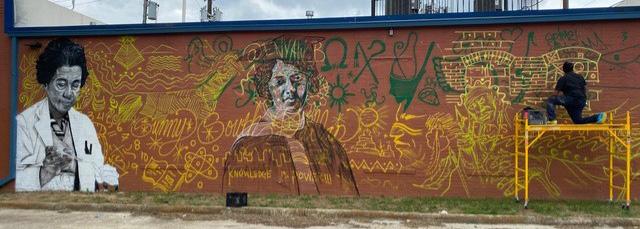
4 minute read
COMMUNITY IMPACT
AT A GLANCE Community Impact

SHINING LIGHT St. Philip’s has partnered with the Shining Light Foundation, a nonprofit whose belief is that art is a powerful tool that ON BLACK is known to bring communities together through shared experiences, reflection, and forming connections that transcend HISTORY THROUGH differences. They have established the Black History Month Mural Project where 28 murals are painted representing the COMMUNITY 28 days in Black History Month. The intent behind this mural project is to educate MURALS society about impactful figures and the significant role and contributions made to our country. Three local artists were chosen to do murals in our neighborhood. One of them is our own Juan Hernandez, alumnus and former art teacher at St. Philip’s. Juan currently teaches at Parish Episcopal School, where he is also an alumnus. His mural fills the entire back wall of the newly opened WeCreation Center at St. Philip’s, and it will be visible to cars traveling west on MLK Jr. Blvd. (from I-45). Juan’s design includes beautiful portraits of three notable Black women in STEM; chemist Alice Ball, inventor Patricia Bath, and biochemist Marie Daly.
ST. PHILIP’S AWARDED PUBLIC SAFETY GRANT FROM CFT
We are thrilled to share that Communities Foundation of Texas (CFT) has awarded St. Philip’s a major grant supporting our community-driven, collaborative approach to address public safety in the Martin Luther King, Jr. Blvd. corridor. CFT is interested in promoting safety in neighborhoods in Dallas County that have been most affected by the recent rise in crime by supporting community-driven approaches to public safety. Safety is fundamental to the health and vitality of our community. It is also critical to attracting communityminded businesses and homeowners to our neighborhood. When crime is high, the community economy stagnates. Revitalization depends on crime reduction as they are interrelated. This project will improve the safety of our community and reduce crime in the MLK corridor by: 1. Transforming nuisance properties into thriving businesses that will serve the neighborhood in three former liquor store spaces on MLK Jr. Blvd. This initiative will attract new healthy businesses, create jobs, and provide amenities desired by the community, including a community engagement center in partnership with the Dallas Police Department. 2.Increasing visibility, attention, and cleanliness to currently dark, vacant, and unsightly buildings and surrounding streetscapes in the MLK Jr. Blvd. corridor by implementing security programs driven by community design for the area to include a courtesy patrol, additional lighting, security cameras, and Ring doorbell distribution and installation. The addition of these crime deterrent elements will make our community safer for neighbors, businesses, and visitors to the area. St. Philip’s project to renovate former liquor stores, reinforced by specific crime deterrent strategies and the improved appearance of the neighborhood, will be transformational and will dramatically improve the safety along the MLK Jr. Blvd. corridor in the Forest District and help realize the community’s goal of a walkable mixeduse neighborhood. This effort will create a foundation for a sustainable, economically vibrant, and diverse neighborhood.

THANK YOU TO WINSTEAD LAW FIRM!
We want to recognize the significant support that the Winstead law firm provides us in pro bono legal services. Team members from Winstead who have invested countless hours in our community development work include St. Philip’s board member David Martin, in addition to Sherry Baldwin, Grant Grubich, John Hind, Laura Hoffmann, Tommy Mann, and Jeremy Wilkins. The Winstead team have been critical in enabling St. Philip’s to reach its prioritized community development goals of providing affordable housing and accessible economic development opportunities to our community. They have also invested significant hours in planning for our future performing arts center, expanded food pantry, athletic field and future community park, by leading the zoning change efforts required by the City of Dallas for these initiatives. We are immensely thankful to the entire Winstead firm for supporting this investment in our South Dallas community.



for community innovation
If you need a space to utilize for meetings, retreats, collaborative special projects, and workshops for your church, organization, or business, consider St. Philip’s WeCreation Center. We’re open for business and nonprofit use!
What is the WeCreation Center used for?
The WeCreation Center invites leaders and innovators from all over Dallas who believe in putting people at the heart of the challenge. The 2500 sq. ft building is a customizable, flexible space designed to serve as a think tank where individuals and organizations are inspired to collaborate and strategize on outcomes for complex community topics. This unique space is available for non-profits, businesses, and individuals to host collaborative events that align with the center’s vision.
Who can use the WeCreation Center?
Members of St. Philip’s School and Community Center’s neighborhood, Local Non-Profits, Government Agencies, Small Businesses, Entrepreneurs, and Corporations
When is the WeCreation Center available?
The WeCreation Center is available Monday - Friday. Saturdays are considered on a case-by-case basis.
Where is the WeCreation Center located?
The WeCreation Center is located at 3016 Colonial Avenue, Dallas, Texas 75215
Who are some of the organizations that have used the WeCreation Center?
Goodwill Industries, the City of Dallas, and Girl Scouts of Northeast Texas
Why was the WeCreation Center created?
The WeCreation Center was created to be a “change chamber” in South Dallas and to do the following: • To provide an affordable and innovative space for use in our community • To explore projects that take on complex challenges and encourage collaboration in solving urgent social issues. • To deeply integrate human centered design and project-based learning practices into neighborhood change efforts.








